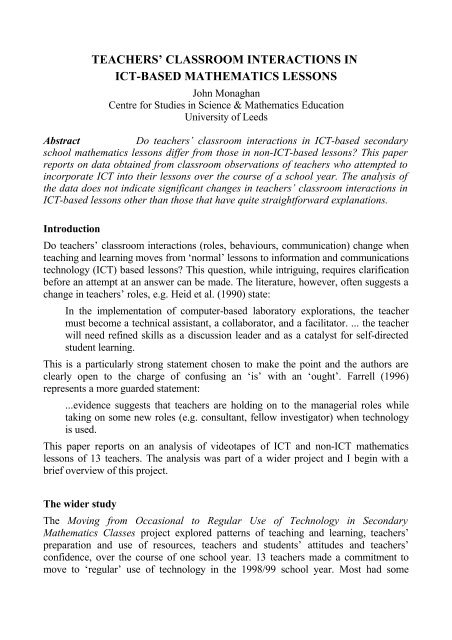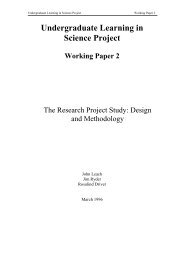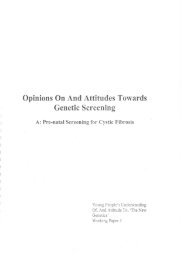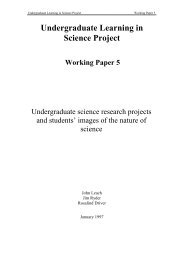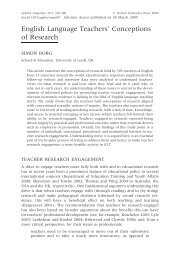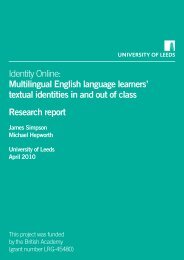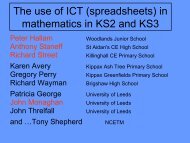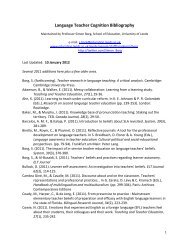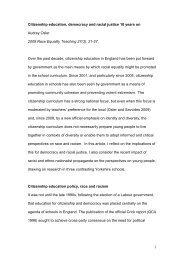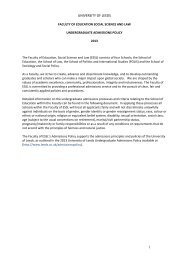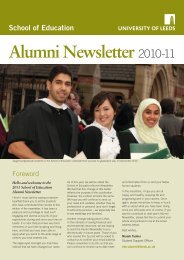Teachers' Classroom Interactions in ICT-based Mathematics Lessons
Teachers' Classroom Interactions in ICT-based Mathematics Lessons
Teachers' Classroom Interactions in ICT-based Mathematics Lessons
You also want an ePaper? Increase the reach of your titles
YUMPU automatically turns print PDFs into web optimized ePapers that Google loves.
TEACHERS’ CLASSROOM INTERACTIONS IN<strong>ICT</strong>-BASED MATHEMATICS LESSONSJohn MonaghanCentre for Studies <strong>in</strong> Science & <strong>Mathematics</strong> EducationUniversity of LeedsAbstract Do teachers’ classroom <strong>in</strong>teractions <strong>in</strong> <strong>ICT</strong>-<strong>based</strong> secondaryschool mathematics lessons differ from those <strong>in</strong> non-<strong>ICT</strong>-<strong>based</strong> lessons? This paperreports on data obta<strong>in</strong>ed from classroom observations of teachers who attempted to<strong>in</strong>corporate <strong>ICT</strong> <strong>in</strong>to their lessons over the course of a school year. The analysis ofthe data does not <strong>in</strong>dicate significant changes <strong>in</strong> teachers’ classroom <strong>in</strong>teractions <strong>in</strong><strong>ICT</strong>-<strong>based</strong> lessons other than those that have quite straightforward explanations.IntroductionDo teachers’ classroom <strong>in</strong>teractions (roles, behaviours, communication) change whenteach<strong>in</strong>g and learn<strong>in</strong>g moves from ‘normal’ lessons to <strong>in</strong>formation and communicationstechnology (<strong>ICT</strong>) <strong>based</strong> lessons? This question, while <strong>in</strong>trigu<strong>in</strong>g, requires clarificationbefore an attempt at an answer can be made. The literature, however, often suggests achange <strong>in</strong> teachers’ roles, e.g. Heid et al. (1990) state:In the implementation of computer-<strong>based</strong> laboratory explorations, the teachermust become a technical assistant, a collaborator, and a facilitator. ... the teacherwill need ref<strong>in</strong>ed skills as a discussion leader and as a catalyst for self-directedstudent learn<strong>in</strong>g.This is a particularly strong statement chosen to make the po<strong>in</strong>t and the authors areclearly open to the charge of confus<strong>in</strong>g an ‘is’ with an ‘ought’. Farrell (1996)represents a more guarded statement:...evidence suggests that teachers are hold<strong>in</strong>g on to the managerial roles whiletak<strong>in</strong>g on some new roles (e.g. consultant, fellow <strong>in</strong>vestigator) when technologyis used.This paper reports on an analysis of videotapes of <strong>ICT</strong> and non-<strong>ICT</strong> mathematicslessons of 13 teachers. The analysis was part of a wider project and I beg<strong>in</strong> with abrief overview of this project.The wider studyThe Mov<strong>in</strong>g from Occasional to Regular Use of Technology <strong>in</strong> Secondary<strong>Mathematics</strong> Classes project explored patterns of teach<strong>in</strong>g and learn<strong>in</strong>g, teachers’preparation and use of resources, teachers and students’ attitudes and teachers’confidence, over the course of one school year. 13 teachers made a commitment tomove to ‘regular’ use of technology <strong>in</strong> the 1998/99 school year. Most had some
experience us<strong>in</strong>g technology <strong>in</strong> their classes but none had made extensive use oftechnology before. Whilst I recognise the difficulties, if not the impossibility, ofcharacteris<strong>in</strong>g ‘ord<strong>in</strong>ary teachers’ these 13 were, <strong>in</strong> an everyday sense, ord<strong>in</strong>aryteachers <strong>in</strong> ord<strong>in</strong>ary schools. Project funds provided a f<strong>in</strong>ancial <strong>in</strong>centive forschools/mathematics departments to be <strong>in</strong>volved and <strong>ICT</strong> experts/enthusiasts whovolunteered to be <strong>in</strong>volved were excluded from the project. The 13 teachers were boththe subjects of the research and teacher-researchers. Most of the teacher-researcherswrote of their experiences <strong>in</strong> a series of articles <strong>in</strong> the UK professional journalMicromath (volumes 14/3, 15/2 and 15/3, 1998/99).‘<strong>ICT</strong> use <strong>in</strong> mathematics classes’ is a collective term for a diffuse range of softwareand hardware. In an attempt to focus on someth<strong>in</strong>g common and manageable projectwork focused on us<strong>in</strong>g technology tools: spreadsheets, graphic packages andcalculators and algebra and geometry systems. In an attempt to keep the project workas realistic as possible <strong>in</strong>dividual team members chose the tools they thought mostappropriate for use with their classes. As these tools have widest application withclasses study<strong>in</strong>g algebra, upper secondary classes (14-18 year olds) were the focus ofthe project work (one project class per teacher).MethodologyThe project made use of a wide range of data collection and analysis tools but here Ireport only on aspects of data collection and analysis relevant to teachers’ observedclassroom behaviours. Apart from not<strong>in</strong>g patterns <strong>in</strong> these behaviours per se I was<strong>in</strong>terested <strong>in</strong> possible patterns of change over the course of a school year. For eachteacher the lessons observed were with the same class, the project class. Our resourceswere not sufficient to observe every lesson over the course of a year. The maximumnumber of lessons it was considered feasible to observe and analyze was estimated tobe four lessons per teacher, 52 lessons <strong>in</strong> total. It was decided that each teacher wouldbe observed prior to start<strong>in</strong>g <strong>ICT</strong> work. I refer to this as the ‘base-l<strong>in</strong>e’ lesson.Thereafter each teacher would be observed near the beg<strong>in</strong>n<strong>in</strong>g, towards the middle andtowards the end of the year <strong>in</strong> <strong>ICT</strong> lessons. With the exception of one teacher, wherethe last <strong>ICT</strong> lesson observation was not observed, this plan was carried out.Lesson observation formats were discussed <strong>in</strong> project team meet<strong>in</strong>gs and the toolchosen for classroom observations was a modified version of the Systematic<strong>Classroom</strong> Analysis Notation (SCAN) (Beeby et al., 1979). It was decided that alllesson observations would be videotaped. A desire for consistency <strong>in</strong> records oflessons and considerable prior experience (often problematic) <strong>in</strong> videotap<strong>in</strong>g lessons<strong>in</strong>formed our practical decisions on how to videotape: the camera was stationary <strong>in</strong> aposition that was as non-obtrusive as possible but which allowed the teacher and allthe students to be seen; a remote cordless microphone was attached to the teacher; thecamera followed the teacher whenever s/he was speak<strong>in</strong>g. Although we were,subjectively, satisfied with suitability of the video record<strong>in</strong>gs for SCAN analysis, there
were some problems which should be noted: the visual image was centred on theteacher and students work<strong>in</strong>g away from the teacher were not recorded; themicrophone picked up the teacher’s words clearly but students’ words were sometimesobscured; the camera did not always produce a clear image of written work or screenimages which was the focus of discussion; technical problems <strong>in</strong> three of the 51lessons resulted <strong>in</strong> much of the sound be<strong>in</strong>g unclear.The rema<strong>in</strong>der of this section describes the modified SCAN system and itsstandardisation and use <strong>in</strong> this research but first it should be noted that the lengthrestriction on this paper prevent a full presentation the data. To avoid repeatedreference to this fact I now collect together all curtailments, mergers and omissions.♦ SCAN descriptors focused on student activity are not presented.♦ A number of SCAN descriptors have been omitted.♦ The SCAN descriptors expla<strong>in</strong><strong>in</strong>g and facilitat<strong>in</strong>g have been merged <strong>in</strong> the Resultssection.♦ SCAN data is presented for only three of the 13 teachers.♦ Details of how the orig<strong>in</strong>al SCAN was modified are not presented (these were notextensive).♦ I have not subjected SCAN to criticism.SCAN works simultaneously on three time scales – ‘activity’, ‘episode’ and ‘event’.<strong>Lessons</strong> are viewed as a series of activities, e.g. teacher exposition, students work<strong>in</strong>g,teacher-student dialogue. Each activity is viewed as a series of episodes, e.g. coach<strong>in</strong>g,expla<strong>in</strong><strong>in</strong>g. Events sub-divide the episodes <strong>in</strong>to social and l<strong>in</strong>guistic categories, e.g.managerial, confirmation. I now provide a fuller description of activities, episodes andevents referred to <strong>in</strong> this paper.Activities: C - whole class exposition. Dn - dialogue, between teacher and a group ofn pupils. D1 for one-to-one dialogue. D2/3 for teacher talk<strong>in</strong>g to a group of two orthree students.Episodes were essentially about what the teachers were do<strong>in</strong>g, e.g. facilitat<strong>in</strong>g,expla<strong>in</strong><strong>in</strong>g. We made a dist<strong>in</strong>ction between technological and mathematical foci <strong>in</strong>episodes. Thus two ‘facilitat<strong>in</strong>gs’, Ft and Fi, and two ‘expla<strong>in</strong><strong>in</strong>gs’, Et and Ei were<strong>in</strong>troduced. Coach<strong>in</strong>g, Co, or elicit<strong>in</strong>g reasons/ideas from students was assumed to bemathematical and not technological.The cod<strong>in</strong>g of the events were ways of describ<strong>in</strong>g what was happen<strong>in</strong>g on a smallscale with<strong>in</strong> an episode. It worked out that essentially each sentence or two wascoded. The l<strong>in</strong>guistic descriptors of the events were <strong>based</strong> on what the teachers weresay<strong>in</strong>g − an assertion, a; an <strong>in</strong>struction, i; a confirmation, cf. The questions, qi or qt,were the questions that the teachers were ask<strong>in</strong>g the pupils, not what the pupils wereask<strong>in</strong>g the teachers. (A confirmation, or rejection, was often the reply of a teacher to apupil question.)
Question qualifiers described the level of the teacher’s question, not the level of apupil’s question nor the general dialogue.Nature or depth of question:α - question requir<strong>in</strong>g recall, s<strong>in</strong>gle fact, s<strong>in</strong>gle act, no process<strong>in</strong>g <strong>in</strong>volvedβ - question of straight forward nature, putt<strong>in</strong>g together several facts.γ - question extend<strong>in</strong>g of previous work <strong>in</strong>volv<strong>in</strong>g new ideasSituation or Level of guidance1 - highly structured, close direction, small number of steps.2 - some guidance, requires connections rather than selection.3 - m<strong>in</strong>imum guidance, open.Cod<strong>in</strong>g were written <strong>in</strong>to grids as below. The numbers denote m<strong>in</strong>utes. 30 secondblocks of time were the basic unit of analysis. Rows one and three were used torecord, respectively, teacher and student, activity. Row two was used to recordepisodes and their l<strong>in</strong>guistic descriptors and qualifiers.1 2 3 4T | | | | |Ep | | | | |St | | | | |A research assistant and I spent over 20 hours cod<strong>in</strong>g 10 m<strong>in</strong>ute fragments until wereached 85% agreement. Thereafter the research assistant coded all tapes of lessons.ResultsTable 1SCAN statistics for three teachersC D1 D2/ Co EFi EFt a i cf qi qt α1 α2 α3 β1 β2 β3 γ1 γ2 γ3 time31 47 39 28 37 15 9 4 15 4 11 292 55 28 13 6 8 64 2 6 3 7 2 343 26 50 21 72 17 25 42 35 34 4 19 1 16 2 364 35 58 3 23 55 44 45 27 18 22 20 2 13 5 351 68 21 39 27 5 2 3 51 36 3 12 702 41 34 4 17 37 1 18 1 4 3 4 3 703 19 74 8 77 61 33 7 33 24 3 1 4 1 594 41 44 10 63 25 65 46 8 37 18 44 1 8 2 641 61 11 46 7 11 34 38 31 7 702 62 25 27 6 39 42 88 2 1 9 5 5 723 61 21 35 38 48 80 21 14 19 22 2 11 714 38 21 31 20 32 61 12 16 2 13 5 59
Table 1 shows SCAN statistics for the four videotaped lessons of three teachers.Column 1 <strong>in</strong>dicates the lesson and the last column shows the length of the lesson <strong>in</strong>m<strong>in</strong>utes. The codes for the other columns have been described earlier. Columns C toEFt represent percentage of lesson times. Columns α1 to γ3 denote raw numbers ofoccurrences, e.g. teacher 1 <strong>in</strong> lesson 1 made 15 assertions.Compar<strong>in</strong>g the 13 non-<strong>ICT</strong> lessons with the 38 <strong>ICT</strong>-<strong>based</strong> lessons seven features standout as markedly different. The figures below represent averages.Table 2SCAN statistics which show a marked difference over all 13 teachersnon-<strong>ICT</strong>(1) the percentage of time spent <strong>in</strong> teacher-whole class exposition (C) 48% 19%(2) the percentage of time teachers spent talk<strong>in</strong>g to two or morestudents (D2/3)(3) the percentage of time teachers spent coach<strong>in</strong>g or elicit<strong>in</strong>gideas from students (Co)(4) the percentage of time teachers spent expla<strong>in</strong><strong>in</strong>g or facilitat<strong>in</strong>gmathematical ideas (EFi)(5) the percentage of time teachers spent expla<strong>in</strong><strong>in</strong>g or facilitat<strong>in</strong>gtechnological features (EFt)<strong>ICT</strong>28% 45%19% 4%44% 29%0% 24%(6) the number of assertions teachers made dur<strong>in</strong>g lessons (a) 9 35(7) the number of <strong>in</strong>structions (or <strong>in</strong>itiat<strong>in</strong>g remarks) teachers madedur<strong>in</strong>g lessons (i)15 50DiscussionI address issues relat<strong>in</strong>g to Table 1 and Table 2 before consider<strong>in</strong>g claims for andaga<strong>in</strong>st changes <strong>in</strong> mathematics teachers roles, behaviours and <strong>in</strong>teractions <strong>in</strong> <strong>ICT</strong>lessons.While the project teachers had a number of common characteristics they also hadmany differences shaped by their attitudes to mathematics and to <strong>ICT</strong>, the ethos oftheir school and of their department and by their classes. The three teachers <strong>in</strong> Table 1were selected to show differences whilst be<strong>in</strong>g representative of the 13 teachers.Teacher 1’s project class were 14 to 15 year olds. The <strong>ICT</strong> lessons used a spreadsheetand a graphic package (pr<strong>in</strong>cipally for transformations). She used <strong>ICT</strong> almost everyTuesday of the project year. My own subjective reaction after her first observed <strong>ICT</strong>lesson was that she had imported her normal classroom technique to the computerroom. Teacher 2’s project class was an Advanced level class of 16 to 17 year olds.The <strong>ICT</strong> work focused on us<strong>in</strong>g Derive but spreadsheet and a graphic package wasused as well. He ‘blocked’ his <strong>ICT</strong> work with the class, i.e. there were periods of
<strong>in</strong>tense use and periods of little use. He stated that he wanted to use Derive as a ‘teachyourself’ tool to break away from the norm of ‘chalk and talk’ with this class and hedesigned worksheets to assist him with this aim. Teacher 3’s project class were 14 to15 year olds who had a graphic calculator each dur<strong>in</strong>g <strong>ICT</strong> lessons (but they did nottake them home). As with teacher 2, <strong>ICT</strong> lessons were ‘blocked’. <strong>ICT</strong> lessonsobserved were predom<strong>in</strong>antly teacher led with the class imitat<strong>in</strong>g the teacher’s keystrokes. Aga<strong>in</strong> my subjective impression after the first observed <strong>ICT</strong> lesson was howsimilar his style was to his teacher-led style <strong>in</strong> non-<strong>ICT</strong> lessons.My subjective impressions of similar styles <strong>in</strong> the first <strong>ICT</strong> and the non-<strong>ICT</strong> lesson ofteachers 1 and 3 is, to some extent, borne out by a comparison of figures <strong>in</strong> the C andD columns for these two lessons of these two teachers. Later <strong>ICT</strong> lessons, however,show less whole class teach<strong>in</strong>g. Aga<strong>in</strong>st any effect or non-effect of <strong>ICT</strong>, however, itmay simply be that mathematics teachers do less exposition later <strong>in</strong> the year as theybecome more familiar with a class.The α1 to γ3 columns of Table 1 are <strong>in</strong>terest<strong>in</strong>g but, perhaps, not surpris<strong>in</strong>g, becauseof the cluster<strong>in</strong>g <strong>in</strong> columns α1 and β2. SCAN is not an <strong>in</strong>strument for discourseanalysis, so statements about teacher-student discourse must be guarded. However, thevery few γ3 occurrences <strong>in</strong> <strong>ICT</strong> lessons must question any general claim that teachersbecome fellow <strong>in</strong>vestigators <strong>in</strong> <strong>ICT</strong> lessons. Where they do occur, however, they occur<strong>in</strong> <strong>ICT</strong> lessons and <strong>in</strong> later lessons (but aga<strong>in</strong> teacher-student familiarity over timecould be a factor).Table 2 shows some marked general differences between <strong>ICT</strong> and non-<strong>ICT</strong> lessonsbut, I believe, these can be expla<strong>in</strong>ed <strong>in</strong> most cases <strong>in</strong> very practical ways. All 13video-taped non-<strong>ICT</strong> lessons were of the form ‘teacher exposition followed bystudents work<strong>in</strong>g on exercises’. The significant reduction <strong>in</strong> teacher-exposition <strong>in</strong> <strong>ICT</strong><strong>based</strong>lessons, (1), may be viewed partially as an organisational factor <strong>in</strong> that six of theteachers prepared their classes before they moved to the computer room. Thepercentage <strong>in</strong>crease <strong>in</strong> time that teachers talked to two or more students, (2), largelyreflects the fact that the availability of computers forced students to work with two ormore to a mach<strong>in</strong>e. It is <strong>in</strong>terest<strong>in</strong>g to note, however, that even when students worked<strong>in</strong> pairs <strong>in</strong> non-<strong>ICT</strong> lessons the teacher talk was largely directed to one of the pair but<strong>in</strong> <strong>ICT</strong>-<strong>based</strong> lessons the teacher talk was largely directed to all students around acomputer. The significance of the coach<strong>in</strong>g figures, (3), lies <strong>in</strong> the relative absence ofthis <strong>in</strong> <strong>ICT</strong>-<strong>based</strong> lessons. I must admit that I cannot expla<strong>in</strong> this but coach<strong>in</strong>g <strong>in</strong> alllessons was <strong>in</strong>terpreted as the teacher po<strong>in</strong>t<strong>in</strong>g out mathematical features withoutreveal<strong>in</strong>g the answer and a relative absence of this <strong>in</strong> <strong>ICT</strong>-lessons does not, to me,suggest that the teachers are act<strong>in</strong>g as ‘a catalyst for self-directed student learn<strong>in</strong>g’.The figures <strong>in</strong> (4) and (5) have obvious explanations <strong>in</strong> the <strong>ICT</strong>, or not, focus of thelesson (if you do not have <strong>ICT</strong> <strong>in</strong> your classroom, then you are not go<strong>in</strong>g to . Thefigures <strong>in</strong> (6) and (7) represent the average number of assertions and <strong>in</strong>structionsteachers made. These averages conceal great variation over teachers and differentlessons. One reason for the greater average <strong>in</strong> <strong>ICT</strong>-<strong>based</strong> lessons was an apparent
propensity <strong>in</strong> <strong>ICT</strong>-<strong>based</strong> lessons for six of the teachers to move quickly around theclass ensur<strong>in</strong>g that technical problems did not slow work down, “copy cell B3 to D3”.There is thus a discrepancy, with many papers report<strong>in</strong>g “Clear changes <strong>in</strong> socialbehaviour and teach<strong>in</strong>g methodologies could be seen by observation of the [computer]lessons” (Schneider, 2000) whereas, apart from changes result<strong>in</strong>g from quitestraightforward reasons, this was not observed to any marked degree <strong>in</strong> the reportedstudy.One possible reason for the apparent discrepancy is that projects which report onchanges <strong>in</strong> teachers’ roles focus on teachers who are technology enthusiasts. Theteachers <strong>in</strong> this project were volunteers who wanted to use <strong>ICT</strong> <strong>in</strong> their teach<strong>in</strong>g, sothere is likely to be someth<strong>in</strong>g else at work here. One th<strong>in</strong>g the project teachers hadlittle prior experience of was of us<strong>in</strong>g <strong>ICT</strong> <strong>in</strong> their mathematics lessons. I suspect thatthe time factor of experience is important (as commented above, Table 1 shows thatlater <strong>ICT</strong> lessons <strong>in</strong>volved less whole class teach<strong>in</strong>g.). In this context time is not justtime learn<strong>in</strong>g how to use <strong>ICT</strong> tools but time to get ‘a feel’ for how lessons will run byhav<strong>in</strong>g tried th<strong>in</strong>gs out. As Moriera and Noss (1995) put it:Develop<strong>in</strong>g a coherent pedagogical approach for learn<strong>in</strong>g with computationalmedia is a far from trivial exercise. Time is an important factor ... it is more amatter of ‘tak<strong>in</strong>g time to percolate’ than just to locate or create new work<strong>in</strong>genvironments for pupils.It must also be considered whether SCAN, or my use of it, is a reason for thediscrepancy between my f<strong>in</strong>d<strong>in</strong>gs and other work. SCAN is certa<strong>in</strong>ly quite a clumsytool for analyz<strong>in</strong>g teacher-student discourse and I used it <strong>in</strong> quite a crude way to makefrequency counts but every effort was made to ensure reliability and validity.My f<strong>in</strong>al consideration <strong>in</strong> this section concerns <strong>in</strong>novation. A danger for researchers <strong>in</strong>the field of the use of <strong>ICT</strong> <strong>in</strong> mathematics classes is a tendency to believe that <strong>ICT</strong><strong>in</strong>novation is somehow unique. Prestage (1996) made a study of teachers’ perceptionsof sequenc<strong>in</strong>g and progression as they implemented changes <strong>in</strong>troduced by the UKNational Curriculum. She claimed the teachers worked <strong>in</strong> three phases over time: (i)try<strong>in</strong>g to accommodate the (assumed) givens without question<strong>in</strong>g, (ii) mak<strong>in</strong>g sense ofthe (assumed) givens, (iii) try<strong>in</strong>g to accommodate the (now personally <strong>in</strong>terpreted)givens with<strong>in</strong> their own frameworks for teach<strong>in</strong>g and learn<strong>in</strong>g. My po<strong>in</strong>t <strong>in</strong> <strong>in</strong>troduc<strong>in</strong>gPrestage’s work is that there are similarities with my comments above on experienceand time and that <strong>ICT</strong> <strong>in</strong>novation shares problems with other types of <strong>in</strong>novation.Cuban (1989), <strong>in</strong> a reaction to a computer symposium where claims were be<strong>in</strong>g madeabout changes <strong>in</strong> teachers’ roles, drew parallels to earlier 20 th century educationaltechnology <strong>in</strong>novations (films, radio, television) and stated that “teachers teach theway they do simply to survive the impossibilities <strong>in</strong>herent <strong>in</strong> the workplace”. Cubanmay be overstat<strong>in</strong>g the case but all 13 project teachers saw their practice as support<strong>in</strong>gexternal curriculum and assessment criteria and felt a moral obligation to their studentsthat <strong>ICT</strong> work had to support learn<strong>in</strong>g which would be assessed without <strong>ICT</strong>. Their
<strong>in</strong>novative work had to support traditional norms. In such conditions it is hardlysurpris<strong>in</strong>g that there were no significant changes <strong>in</strong> these 13 teachers’ classroom<strong>in</strong>teractions <strong>in</strong> <strong>ICT</strong>-<strong>based</strong> lessons other than those that have quite straightforwardexplanations.The conditions and constra<strong>in</strong>ts that teachers work under po<strong>in</strong>t to the need for furtherresearch <strong>in</strong> this field. Like Cuban (1989) I do not th<strong>in</strong>k it is enough to expect that amach<strong>in</strong>e will affect teachers’ classroom <strong>in</strong>teractions. Researchers and policy makersshould be look<strong>in</strong>g at how the curriculum and school structures might allow for newroles for teacher-student <strong>in</strong>teraction − with and without <strong>ICT</strong>.AcknowledgementThe work reported on <strong>in</strong> this paper was funded by the Economic and Social ResearchCouncil, UK, Award Number R000222618.ReferencesBeeby, T., Burkhardt, H. & Fraser, R. (1979) Systematic <strong>Classroom</strong> AnalysisNotation for <strong>Mathematics</strong> <strong>Lessons</strong>. Nott<strong>in</strong>gham: Shell Centre for MathematicalEducation.Cuban, L. (1989)Neoprogressive Visions and Organizational Realities. HarvardEducational Review, 59, 217-222.Farrell, A. (1996) Roles and Behaviours <strong>in</strong> Technology-<strong>in</strong>tegrated Precalculus<strong>Classroom</strong>s. Journal of Mathematical Behaviour, 15, 35-53.Heid, M.K., Sheets, C. & Matras, M.A. (1990) Computer-enhanced Algebra: NewRoles and Challenges for Teachers and Students’, <strong>in</strong> Cooney, T. (ed.),Teach<strong>in</strong>g and Learn<strong>in</strong>g <strong>Mathematics</strong> <strong>in</strong> the 1990s, NCTM 1990 Yearbook.Reston,Va.: NCTM.Moreira, C. & Noss, R. (1995) Understand<strong>in</strong>g teachers’ attitudes to change <strong>in</strong> aLogomathematics environment. Educational Studies <strong>in</strong> <strong>Mathematics</strong>, 28, 155-176.Prestage, S. (1996) Teachers’ Perception of Sequenc<strong>in</strong>g and Progression <strong>in</strong> the<strong>Mathematics</strong> National Curriculum, <strong>in</strong>: D.C.Johnson & A. Millet (Eds)Implement<strong>in</strong>g the <strong>Mathematics</strong> National Curriculum: Policy, Politics andPractice (London, Paul Chapman).Schneider, E. (2000) Teacher Experiences with the Use of a CAS <strong>in</strong> a <strong>Mathematics</strong><strong>Classroom</strong>. International Journal of Computer Algebra <strong>in</strong> <strong>Mathematics</strong>Education, 7(2), 119-141.


